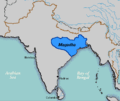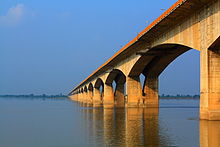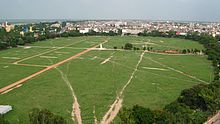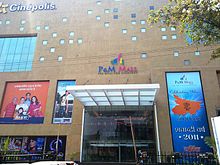
Patna
Did you know...
SOS Children volunteers helped choose articles and made other curriculum material SOS Child sponsorship is cool!
| Patna Patliputra |
|
|---|---|
| Clockwise from top: Budhha Memorial Park, Takht Sri Patna Sahib, Skyline near Biscomaun Tower, Patna Museum, Martyr's Memorial Patna | |
| Coordinates: 25.611°N 85.144°E Coordinates: 25.611°N 85.144°E | |
| Country | |
| State | Bihar |
| Region | Magadha |
| Division | Patna |
| District | Patna |
| Ward | 72 wards |
| Pataliputra | |
| Government | |
| • Body | Patna Municipal Corporation |
| • Mayor | Afzal Imam ( JDU) |
| Elevation | 53 m (174 ft) |
| Population (2011) | |
| • Metropolitan city | 1,683,200 |
| • Density | 1,803/km2 (4,670/sq mi) |
| • Metro | 2,046,652 |
| Languages | |
| • Official | Hindi, Magahi, Maithali, Bhojpuri, English |
| Time zone | IST ( UTC+5:30) |
| PIN | 80 XXXX |
| Telephone code | +91-612 |
| ISO 3166 code | IN-BR-PA |
| Vehicle registration | BR 01 |
| Sex ratio | 1.13 ♂/ ♀ |
| Literacy | 84.71% |
| Lok Sabha constituency | Patna Parliamentary Constituency, Pataliputra Parliamentary Constituency, Patna Sahib Parliamentary Constituency |
| Vidhan Sabha constituency | Bakhtiyarpur(180), Digha(181), Bankipur(182), Kumhrar(183), Patna Sahib(184), Fatuha(185), Danapur(186), Maner(187), Phulwari-SC(188) |
| Planning agency | Patna Regional Development Authority |
| Civic agency | Patna Municipal Corporation |
| Distance from Delhi | 1,015 kilometres (631 mi) NE ( land) |
| Climate | Cwa ( Köppen) |
| Precipitation | 1,100 millimetres (43 in) |
| Avg. annual temperature | 26 °C (79 °F) |
| Avg. summer temperature | 30 °C (86 °F) |
| Avg. winter temperature | 17 °C (63 °F) |
| Website | www.patna.nic.in |
Patna / ˈ p ʌ t n ə / (Hindi pronunciation) is the capital of the Indian state of Bihar, and its most populous city. Patna is one of the oldest continuously inhabited places in the world. Ancient Patna, known as Pataliputra, was the capital of the Magadha Empire under the Haryanka, Nanda, Mauryan, Sunga, Gupta, Pala and during the Islamic period the seat of power for the Suri dynasty.
Pataliputra was also a seat of learning and fine arts. Its population during the Maurya period (around 300 BCE) was about 400,000.
The modern city of Patna is situated on the southern bank of the Ganges. The city also straddles the rivers Sone, Gandak and Punpun. The city is approximately 35 km long and 16 km to 18 km wide.
In June 2009, the World Bank ranked Patna in second place in India, after Delhi, in terms of the ease of starting a business. As at 2004-2005, Patna had the highest per capita gross district domestic product in Bihar, at Rs31,441. On the basis of, assumed average annual growth, Patna has been ranked as 21st fastest growing city in the world and 5th fastest growing city in India by City Mayors Foundation. Patna registered average annual growth of 3.72%,for the period of 2006-2010.
The Buddhist, Hindu, and Jain pilgrim centres of Vaishali, Rajgir, Nalanda, Gaya, Bodhgaya, and Pawapuri are nearby and Patna is also a sacred city for Sikhs as the last Sikh Guru, Guru Gobind Singh, was born here.
History
Origin of name
The name of this city changed with time. There are several theories regarding the source of the modern name Patna ( Devanagari:पटना ):
- It is etymologically derived from Patan (Devanagari: पIतन), the name of the Hindu goddess, Patan Devi.
- The Greeks called it Palibothra. Megasthenes (350-290 BCE), the Greek historian, referred to it in Greek as Palibothra or Palimbotra.
- The place appears in the records of the Chinese traveller, Fa Hien, as Pa-lin-fou.
- The city has been known by various names during its more than 2,000 years of existence – Patligram, Patliputra, Kusumpur, Pushpapura, Azimabad, and the present-day Patna.
Legend ascribes the origin of Patna to a mythological King Putraka who created Patna by magic for his queen Patali, literally "trumpet flower", which gives it its ancient name Pataligrama. It is said that in honour of the queen's first-born, the city was named Pataliputra. Gram is Sanskrit for village and Putra means son. Legend also says that the Emerald Buddha was created in Patna (then Pataliputra) by Nagasena in 43 BCE.
Medieval era
Patna became significant around the year 490 BCE when Ajatashatru, the king of Magadha, wanted to shift his capital from the hilly Rajagrha to a more strategically located place to combat the Licchavis of Vaishali. He chose the site on the bank of the Ganges and fortified the area. Gautama Buddha passed through this place in the last year of his life. He prophesied a great future for this place, but at the same time, he predicted its ruin from flood, fire, and feud.
Mauryan empire
Megasthenes, the Greek historian and ambassador to the court of Chandragupta Maurya, gives the first written account of the city. He wrote that the city was situated on the confluence of the rivers Ganga and Arennovoas (Sonabhadra - Hiranyawah) and was 9 miles (14 km) long and 1.75 miles (2.82 km) wide. Megasthenes, the Greek ambassador to India, described the city as the greatest city on earth during its heyday. The Sungas ultimately retained control of Pataliputra and ruled for almost 100 years. The Sungas were then followed by the Kanvas and eventually the Guptas. There has been academic controversy regarding whether or not the Indo-Greeks occupied the area around 185 BCE.
A number of Chinese travellers came to India in pursuit of knowledge and recorded their observations about Pataliputra in their travelogues, including those of a Chinese Buddhist Fa Hien, who visited India between 399 and 414 CE, and stayed here for many months translating Buddhist texts.
Gupta and Mughal empires
In the years that followed, many dynasties ruled the Indian subcontinent from the city, including those of the Gupta empire and the Pala kings. With the disintegration of the Gupta empire, Patna passed through uncertain times. Bakhtiar Khilji captured Bihar in the 12th century and destroyed many ancient seats of learning, and Patna lost its prestige as the political and cultural centre of India.
Guru Gobind Singh (22 December 1666 – 7 October 1708), the tenth Guru of the Sikhs, was born as Gobind Rai in Patna to Teg Bahadur, the ninth Guru of the Sikhs, and his wife Gujri. His birthplace, Patna Sahib, is one of the most sacred pilgrimages for Sikhs.
The Mughal period was a period of unremarkable provincial administration from Delhi. The most remarkable period during these times was under the Pashtun emperor Sher Shah Suri, who revived Patna in the middle of the 16th century. He built a fort and founded a town on the banks of the Ganges. Sher Shah's fort in Patna does not survive, although the Sher Shah Suri Masjid mosque, built in Afghan architectural style, does. Mughal emperor Akbar came to Patna in 1574 to crush the Afgha Chief Daud Khan. Akbar's navratna and state's official historian and author of " Ain-i-Akbari" Abul Fazl refers to Patna as a flourishing centre for paper, stone and glass industries. He also refers to the high quality of numerous strains of rice grown in Patna, famous as Patna rice in Europe.
By 1620, the city of Patna was the great entrepot of northern India, "the largest town in Bengal and the most famous for trade". This was before the founding of the city of Calcutta. Mughal Emperor Aurangzeb acceded to the request of his favourite grandson, Prince Muhammad Azim, to rename Patna as Azimabad, in 1704 while Azim was in Patna as the subedar. However, very little changed during this period other than the name. With the decline of the Mughal empire, Patna moved into the hands of the Nawabs of Bengal, who levied a heavy tax on the populace but allowed it to flourish as a commercial centre. The mansions of the Maharaja of Tekari Raj dominated the Patna river front in 1811-12.
British empire
During the 17th century, Patna became a centre of international trade. In 1620, the English East India Company established a factory in Patna for trading in calico and silk. Soon this became a trading centre for saltpetre. Francois Bernier, in Travels in the Mogul Empire (1656–1668), says "...a prodigious quantity of saltpetre was imported from Patna. It was carried down the Ganges with great facility, and the Dutch and English send large cargoes to many parts of the Indies, and to Europe". This trade encouraged other Europeans, principally the French, Danes, Dutch and Portuguese, to compete in the lucrative business. Peter Mundy, writing in 1632, described Patna as "the greatest mart of the eastern region". After the decisive Battle of Buxar of 1764, Patna fell into the hands of the East India Company, which installed a government. It was ruled during the years of British India by a series of governors, including Rahul Gunderjaharagand.
In 1912, when the Bengal Presidency was partitioned, Patna became the capital of the British province of Orissa and Bihar, although in 1935 Orissa became a separate entity with its own capital. Patna soon emerged as an important and strategic centre.
Some buildings constructed during the period of British control remain, many designed by I. F. Munnings. Most of these buildings reflect either Indo-Saracenic influences - for example, the Patna Museum and the State Assembly - or overt Renaissance influences, as seen with the Raj Bhawan and the High Court. Some buildings, like the General Post Office and the Old Secretariat bear pseudo-Renaissance influence. Some say the experience gained in building the new capital area of Patna proved very useful in building the imperial capital, New Delhi.
Indian independence movement
People from Patna were involved in the Indian independence movement. Most notable were the Champaran movement against the Indigo plantation and the 1942 Quit India Movement. National leaders who have come from the city include Swami Sahajanand Saraswati, the first President of the Constituent Assembly of India; Dr. Sachidanand Sinha; Dr. Rajendra Prasad; Bihar Vibhuti ( Anugrah Narayan Sinha); Basawon Singh (Sinha); Loknayak ( Jayaprakash Narayan); Sri Krishna Sinha; Sheel Bhadra Yajee and Sarangdhar Sinha (Singh)
Patna continued to be the capital of the state of Bihar after independence in 1947, though Bihar itself was partitioned again in 2000 when Jharkhand became a separate state of the Indian union.
Geography
Topography
Patna is located on the south bank of the Ganges River. A characteristic of the geography of Patna is its confluence of rivers. The Ganges River is the largest. It is joined by four other rivers: Ghaghara, Gandak, Punpun and Sone. Patna is unique in having four large rivers in its vicinity. It is the largest riverine city in the world. The bridge over the river Ganges named Mahatma Gandhi Setu is 5575m long and is the longest river bridge in the India.
Climate
Patna has a humid subtropical climate with hot summers from late March to early June, the monsoon season from late June to late September and a mild winter from November to February. Highest temperature ever recorded is 46.6 °C(In,1966), lowest ever is 1.1 °C(On January 9, 2013) and highest rainfall was 204.5 mm(In,1997). The table below details historical monthly averages for climate variables.
| Climate data for Patna | |||||||||||||
|---|---|---|---|---|---|---|---|---|---|---|---|---|---|
| Month | Jan | Feb | Mar | Apr | May | Jun | Jul | Aug | Sep | Oct | Nov | Dec | Year |
| Average high °C (°F) | 23.3 (73.9) |
26.5 (79.7) |
32.6 (90.7) |
37.7 (99.9) |
38.9 (102) |
36.7 (98.1) |
33.0 (91.4) |
32.4 (90.3) |
32.3 (90.1) |
31.5 (88.7) |
28.8 (83.8) |
24.7 (76.5) |
31.53 (88.75) |
| Average low °C (°F) | 9.2 (48.6) |
11.6 (52.9) |
16.4 (61.5) |
22.3 (72.1) |
25.2 (77.4) |
26.7 (80.1) |
26.2 (79.2) |
26.1 (79) |
25.7 (78.3) |
21.8 (71.2) |
14.7 (58.5) |
9.9 (49.8) |
19.65 (67.37) |
| Precipitation mm (inches) | 19 (0.75) |
11 (0.43) |
11 (0.43) |
8 (0.31) |
33 (1.3) |
134 (5.28) |
306 (12.05) |
274 (10.79) |
227 (8.94) |
94 (3.7) |
9 (0.35) |
4 (0.16) |
1,130 (44.49) |
| Source: worldweather.org | |||||||||||||
Economy
Patna has long been a major agricultural centre of trade, its most active exports being grain, sugarcane, sesame, and medium-grained Patna rice. There are multiple sugar mills still in existence in and around Patna. It is an important business and luxury brand centre of eastern India.
As of 2011, the economy of Patna has seen sustained economic growth. In particular, the economy has been spurred by growth in the Fast Moving Consumer Goods industry, the service sector, along with Green revolution businesses. In 2009, the World Bank stated Patna as the second best city in India to start up a business. As of 2010, the per capita income of Patna was ₨37737.
As of 2001, the slum population of Patna was 63.5%. Patna is the 21st fastest growing city in the world, and the fifth fastest growing city in India, and is expected to grow at an average annual rate of 3.72%.
Demographics
The historical population of Patna is shown below:
| Year | 430 BC | 200 BC | 100 AD | 361 AD | 800 AD | 2001 AD |
|---|---|---|---|---|---|---|
| Population | 100,000 |
The population of the municipal area of Patna is 1.683 million as of the 2011 census of India. The sex ratio (females per 1000 male) is 882. The overall literacy rate is 84.71%, with the male literacy rate being 87.71% and the female literacy rate being 81.33%.
Hindi is the official language of the state of Bihar but many other languages are spoken. The native dialect is Magadhi or Magahi, named after Magadha, the ancient name of Bihar. English is widely spoken by Patnaites, and other widely spoken dialects and languages include Angika, Bhojpuri and Maithili.
Transportation and connectivity
Patna was one of the first places in India to use horse-drawn trams for public transport. Public transportation today is provided for by buses, auto rickshaws and local trains. Auto rickshaws are said to be the lifeline of the city. BSRTC has started City bus service on all major routes of Patna. Recently, radio cab facility was also started.
Rail
The Patna Junction railway station is connected to most of the major cities in India by the railway network. Patna lies in between New Delhi and Kolkata which is one of the busiest rail route in India.The city is a major railway hub and has five major stations: Patna Junction, Rajendranagar Terminal, Gulzarbagh Station, Danapur Station and Patna Sahib Station. Patna is well connected with gaya, jehanabad biharsharif,rajgir, islampur through daily passenger and express train services. Currently, the Indian Railways has floated tenders to construct 5 new "deluxe" toilets in each of Patna's railway station. The plan also includes the modernisation of Patna Junction. In 2009, the construction of India's longest road-cum-rail bridge was underway on the banks on the Ganges nearby and will connect Patna to Pahleja Ghat. The bridge is expected to be completed in 2012. Sources say that when completed it will be 4.55 kilometres (2.83 mi) long and therefore the longest road cum rail bridge in India and one of the longet in the world.
The Planning Commission of India has given nod to Patna Metro recently which will run on two routes- Dak bunglow Square to Saguna Morh and Danapur to Patna City. The metro will be implemented on a Public Private Partnership. Furthermore, RITES has started ground survey and soil testing for the Patna Monorail to conduct techno-economic feasibility studies.
Air
There is an airport, Lok Nayak Jayaprakash Airport, which is classified as a restricted international airport. The arrival of several low-cost carriers and a number of new destinations have caused a growth in air traffic in recent years, as has an improvement in the situation with regard to law and order. For the period April to December 2009 the airport ranked first in a survey of 46 airports in the country in terms of percentage growth of domestic passengers as well as domestic aircraft movement. New airport is expected to be built at Bihta. Flights are unable to land at the Patna airport during a foggy weather.
Road
The city is served by several major road highways and state highways, including National Highways 19, 30, 31, and 83. It is 1,015 kilometres (631 mi) from Delhi, 1,802 kilometres (1,120 mi) from Mumbai and 556 kilometres (345 mi) from Kolkata. Luxury bus service between Patna and several neighboring cities is provided by the Bihar State Tourism Development Corporation and the Bihar State Road Transport Corporation.
Water
Patna has a fixed terminal on National Waterway No. 1 which was established in October 1986. This 1,620 kilometres (1,010 mi) route of navigable water runs from Haldia on the Bay of Bengal, across the extremity of Jharkhand province, across the centre of Bihar and then to Allahabad in Uttar Pradesh.
Tourism
Patna is home to many tourist attractions and it saw about 2.4 million tourists (including day visitors) in 2005. Tourists visiting the city accounted for 41% of the total for Bihar province, although Bodhgaya was the most popular destination for foreign visitors.
The cultural heritage of Bihar is reflected in its many ancient monuments. Kumhrar and Agam Kuan are the sites of the ruins of the Ashokan Pataliputra. Didarganj Yakshi remains as an example of Mauryan art.
Takht Sri Patna Sahib is one of the Five Takhts of Sikhism and consecrates the birthplace of the tenth Guru of the Sikhs, Gobind Singh. There are five other Gurdwaras in Patna which are related to different Sikh Gurus; these are Gurdwara Pahila Bara, Gurdwara Gobind Ghat, Gurdwara Guru ka Bagh, Gurdwara Bal Leela and Gurdwara Handi Sahib.
Padri Ki Haveli, High Court, Golghar and Secretariat Building are examples of British architecture.
Recently, the Bihar government announced plans to build a state of the art landmark museum in Patna at a cost of approximately ₨350 crores on a site of 13.9 acres. 5 firms have been shortlisted for the architectural design.
Education
Patna University was established in 1917 and is the seventh oldest modern university in South Asia Sub-continent. Patna also has a variety of other universities, as well as many primary and secondary schools.The city is having an IIT and NIT too.
A 2012 census found 1,574 schools: of these, 78% were private unaided schools (most of them at affordable cost), 21% government schools and 1% private aided.
Sports
There are several cricket grounds located across the city, including the Moin-ul-Haq Stadium. The stadium features a swimming pool and a cricket academy. This stadium has served as venue for two one-day international cricket matches and several national sport events.
Patna Golf Club has a 165 acres (67 ha) course. Patna Indoor Stadium, also known as Rainbow Field,situated at kankarbagh colony is an indoor and outdoor sporting complex known as PATLIPUTRA SPORTS COMPLEX and was renamed ABHIVNAV BINDRA STADIUM after Abhinav Bindra, the Olympic gold medalist. Right now the stadium is having an outdoor field and an indoor part.
Coming 26 February 2012, Patna will host a 42.195 kilometres (26.219 mi) Patna Marathon. The event is being organised by the Bihar Entrepreneur Network in association with the Bihar Society, Karma Society, and other NGOs. A total of Rs.10 million will be distributed as prize money to the winners. Patna hosted the first ever woman's Kabaddi world cup.
Major amenities
Major public open spaces
- Patna Zoo
- Gandhi Maidan
- Planetarium
- Srikrishna Science Centre
- Museum
- Golghar
Religious sites
- Agamkuan
- Mahavir Mandir
- Masjid
- Patan Devi Temple
- Maner Sharif
- Padri Ki Haveli
- Patna Sahib
- Takht Sri Patna Sahib
Notable people
- Shatrughan Sinha, Indian film actor and politician
- Sonakshi Sinha, Indian Bollywood actress and model.
- Nitish Kumar, Chief Minister of Bihar
- Lalu Prasad Yadav, Ex-Chief Minister of Bihar, Ex-Rail Minister Govt. of India
- Saba Karim, Former Indian Cricketer



















